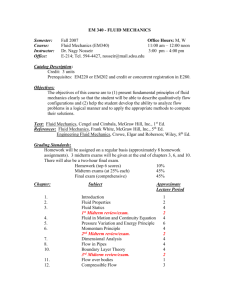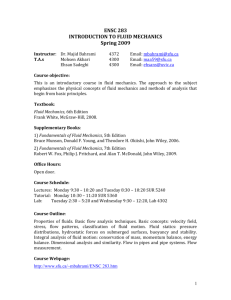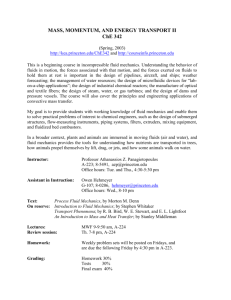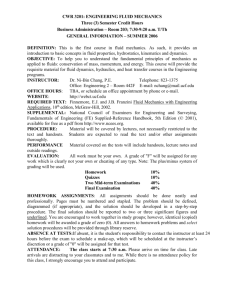Intro-FM_Hyunse
advertisement
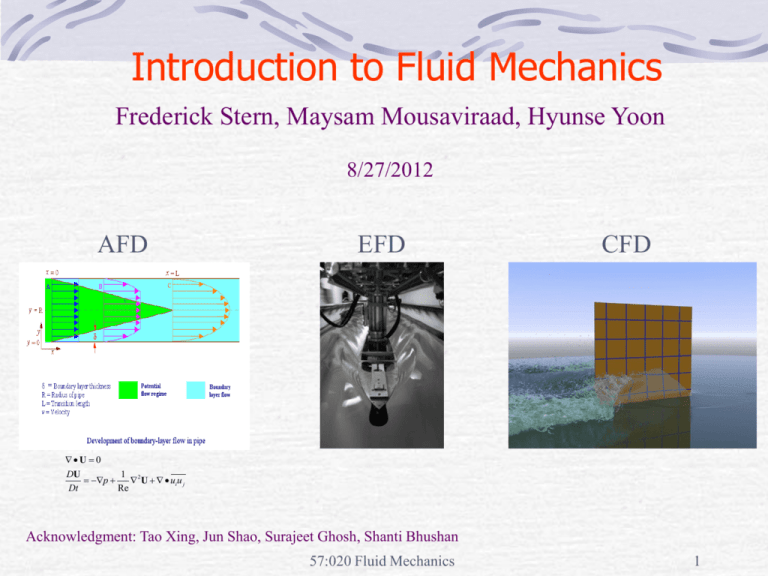
Introduction to Fluid Mechanics Frederick Stern, Maysam Mousaviraad, Hyunse Yoon 8/27/2012 AFD EFD CFD U 0 DU 1 2 p U ui u j Dt Re Acknowledgment: Tao Xing, Jun Shao, Surajeet Ghosh, Shanti Bhushan 57:020 Fluid Mechanics 1 Fluid Mechanics • Fluids essential to life • Human body 65% water • Earth’s surface is 2/3 water • Atmosphere extends 17km above the earth’s surface • History shaped by fluid mechanics • • • • Geomorphology Human migration and civilization Modern scientific and mathematical theories and methods Warfare • Affects every part of our lives 57:020 Fluid Mechanics 2 History Faces of Fluid Mechanics Archimedes (C. 287-212 BC) Navier (1785-1836) Newton (1642-1727) Stokes (1819-1903) Leibniz (1646-1716) Reynolds (1842-1912) Prandtl Bernoulli (1667-1748) (1875-1953) 57:020 Fluid Mechanics Taylor (1886-1975) Euler (1707-1783) Kolmogorov (1903-1987) 3 Significance • Fluids omnipresent • Weather & climate • Vehicles: automobiles, trains, ships, and planes, etc. • Environment • Physiology and medicine • Sports & recreation • Many other examples! 57:020 Fluid Mechanics 4 Weather & Climate Tornadoes Thunderstorm Global Climate Hurricanes 57:020 Fluid Mechanics 5 Vehicles Surface ships Aircraft High-speed rail 57:020 Fluid Mechanics Submarines 6 Environment Air pollution 57:020 Fluid Mechanics River hydraulics 7 Physiology and Medicine Blood pump Ventricular assist device 57:020 Fluid Mechanics 8 Sports & Recreation Water sports Cycling Auto racing Offshore racing Surfing 57:020 Fluid Mechanics 9 Fluids Engineering 57:020 Fluid Mechanics 10 Analytical Fluid Dynamics • The theory of mathematical physics problem formulation • Control volume & differential analysis • Exact solutions only exist for simple geometry and conditions • Approximate solutions for practical applications • Linear • Empirical relations using EFD data 57:020 Fluid Mechanics 11 Analytical Fluid Dynamics • Lecture Part of Fluid Class • • • • • • • • Definition and fluids properties Fluid statics Fluids in motion Continuity, momentum, and energy principles Dimensional analysis and similitude Surface resistance Flow in conduits Drag and lift 57:020 Fluid Mechanics 12 Analytical Fluid Dynamics • Example: laminar pipe flow UD 2000 Assumptions: Fully developed, Low Re Approach: Simplify momentum equation, Schematic integrate, apply boundary conditions to determine integration constants and use energy equation to calculate head loss 0 2 0 0 u 2u Du p 2 2 gx Dt x y x Exact solution : u(r) 1 ( p )(R2 r 2) 4 x 8 du 8 w dy w 64 f Friction factor: V 2 V 2 Re p1 p2 L V 2 32 LV hf f Head loss: z1 z2 h f D 2g D2 57:020 Fluid Mechanics 13 Analytical Fluid Dynamics • Example: turbulent flow in smooth pipe( Re 3000) Three layer concept (using dimensional analysis) u u u 1. u* w 0 y 5 Overlap layer (viscous and turbulent shear important) u 3. * Laminar sub-layer (viscous shear dominates) u y 2. y yu * 1 ln y B 20 y 105 (=0.41, B=5.5) Outer layer (turbulent shear dominates) Assume log-law is valid across entire pipe: U u r 5 f 1 y 10 * u r0 u r u* 1 r0 r u * ln B Integration for average velocity and using EFD data to adjust constants: 1 2log Re f 1 2 .8 f 57:020 Fluid Mechanics 14 Analytical Fluid Dynamics • Example: turbulent flow in rough pipe Both laminar sublayer and overlap layer are affected by roughness u u y k Inner layer: Outer layer: unaffected u Overlap layer: 1 ln y constant k Three regimes of flow depending on k+ 1. K+<5, hydraulically smooth (no effect of roughness) 2. 5 < K+< 70, transitional roughness (Re dependent) 3. K+> 70, fully rough (independent Re) For 3, using EFD data to adjust constants: u 1 ln y 8.5 f Re k Friction factor: 57:020 Fluid Mechanics 1 k D 2log 3.7 f 15 Analytical Fluid Dynamics • Example: Moody diagram for turbulent pipe flow Composite Log-Law for smooth and rough pipes is given by the Moody diagram: 1 f 1 2 k D 2.51 2log 12 3.7 Re f 57:020 Fluid Mechanics 16 Experimental Fluid Dynamics (EFD) Definition: Use of experimental methodology and procedures for solving fluids engineering systems, including full and model scales, large and table top facilities, measurement systems (instrumentation, data acquisition and data reduction), uncertainty analysis, and dimensional analysis and similarity. EFD philosophy: • Decisions on conducting experiments are governed by the ability of the expected test outcome, to achieve the test objectives within allowable uncertainties. • Integration of UA into all test phases should be a key part of entire experimental program • test design • determination of error sources • estimation of uncertainty • documentation of the results 57:020 Fluid Mechanics 17 Purpose • Science & Technology: understand and investigate a phenomenon/process, substantiate and validate a theory (hypothesis) • Research & Development: document a process/system, provide benchmark data (standard procedures, validations), calibrate instruments, equipment, and facilities • Industry: design optimization and analysis, provide data for direct use, product liability, and acceptance • Teaching: instruction/demonstration 57:020 Fluid Mechanics 18 Applications of EFD Application in science & technology Application in research & development Picture of Karman vortex shedding Tropic Wind Tunnel has the ability to create temperatures ranging from 0 to 165 degrees Fahrenheit and simulate rain 57:020 Fluid Mechanics 19 Applications of EFD (cont’d) Example of industrial application NASA's cryogenic wind tunnel simulates flight conditions for scale models--a critical tool in designing airplanes. Application in teaching Fluid dynamics laboratory 57:020 Fluid Mechanics 20 Full and model scale • Scales: model, and full-scale • Selection of the model scale: governed by dimensional analysis and similarity 57:020 Fluid Mechanics 21 Measurement systems • Instrumentation • • • • • Load cell to measure forces and moments Pressure transducers Pitot tubes Hotwire anemometry PIV, LDV • Data acquisition • • • • Serial port devices Desktop PC’s Plug-in data acquisition boards Data Acquisition software - Labview • Data analysis and data reduction • Data reduction equations • Spectral analysis 57:020 Fluid Mechanics 22 Instrumentation Pitot tube Load cell 3D - PIV Hotwire 57:020 Fluid Mechanics 23 Data acquisition system Hardware Software - Labview 57:020 Fluid Mechanics 24 Data reduction methods TEMPERATURE WATER TEMPERATURE AIR • Data reduction equations T Ta w B , PT Tw • Spectral analysis B T , PT a w a PIPE PRESSURE VENTURI PRESSURE INDIVIDU MEASUREM SYSTEM z SM Bz , Pz z DM Bz , Pz MEASUREM OF INDIVID VARIABL SM SM DM = F(T ) w w a = F(Ta ) Q = F(z DM ) f = F( , , z w a 2 SM , Q) = gD 8LQ 5 2 w (z - z ) a SM i SM j DM DATA REDUC EQUATIO 2 g w u (r ) z SM Stag r z SM Stat a f B f , Pfequations Example of data reduction 57:020 Fluid Mechanics EXPERIMEN RESULT 25 Spectral analysis Aim: To analyze the natural unsteadiness of the separated flow, around a surface piercing strut, using FFT. FFT: Converts a function from amplitude as function of time to amplitude as function of frequency Fast Fourier Transform Free-surface wave elevation contours Surface piercing strut FFT of wave elevation 57:020 Fluid Mechanics Time history of wave elevation Power spectral density of wave elevation 26 Uncertainty analysis Rigorous methodology for uncertainty assessment using statistical and engineering concepts ELEMENTAL ERROR SOURCES 1 2 J INDIVIDUAL MEASUREMENT SYSTEMS X 1 B ,P X 2 B ,P X J B,P MEASUREMENT OF INDIVIDUAL VARIABLES 1 1 2 2 J J r = r (X , X ,......, X ) 1 2 r B, P r J r 57:020 Fluid Mechanics DATA REDUCTION EQUATION EXPERIMENTAL RESULT 27 Dimensional analysis • Definition : Dimensional analysis is a process of formulating fluid mechanics problems in in terms of non-dimensional variables and parameters. • Why is it used : • Reduction in variables ( If F(A1, A2, … , An) = 0, then f(P1, P2, … Pr < n) = 0, where, F = functional form, Ai = dimensional variables, Pj = non-dimensional parameters, m = number of important dimensions, n = number of dimensional variables, r = n – m ). Thereby the number of experiments required to determine f vs. F is reduced. • Helps in understanding physics • Useful in data analysis and modeling • Enables scaling of different physical dimensions and fluid properties Example Drag = f(V, L, r, m, c, t, e, T, etc.) From dimensional analysis, Vortex shedding behind cylinder Examples of dimensionless quantities : Reynolds number, Froude Number, Strouhal number, Euler number, etc. 57:020 Fluid Mechanics 28 Similarity and model testing • Definition : Flow conditions for a model test are completely similar if all relevant dimensionless parameters have the same corresponding values for model and prototype. • Pi model = Pi prototype i = 1 • Enables extrapolation from model to full scale • However, complete similarity usually not possible. Therefore, often it is necessary to use Re, or Fr, or Ma scaling, i.e., select most important Pand accommodate others as best possible. • Types of similarity: • Geometric Similarity : all body dimensions in all three coordinates have the same linear-scale ratios. • Kinematic Similarity : homologous (same relative position) particles lie at homologous points at homologous times. • Dynamic Similarity : in addition to the requirements for kinematic similarity the model and prototype forces must be in a constant ratio. 57:020 Fluid Mechanics 29 Particle Image Velocimetry (PIV) • Definition : PIV measures whole velocity fields by taking two images shortly after each other and calculating the distance individual particles travelled within this time. From the known time difference and the measured displacement the velocity is calculated. •Seeding: The flow medium must be seeded with particles. • Double Pulsed Laser: Two laser pulses illuminate these particles with short time difference. • Light Sheet Optics: Laser light is formed into a thin light plane guided into the flow medium. • CCD Camera: A fast frame-transfer CCD captures two frames exposed by laser pulses. •Timing Controller: Highly accurate electronics control the laser and camera(s). • Software: Particle image capture, evaluation and display. 57:020 Fluid Mechanics 30 EFD at UI: IIHR Flume, Towing Tank, Wave Basin Facilities Idealized/Practical Geometries; Small/Large Facilities: • • • Development of measurement systems for small/large facilities Global/local flow measurements including physics/modeling; EFD benchmark data with UA for CFD validation (K. Hokusai, 1832) 1) FLUME (30 m 0.91 m 0.45 m) • Free surface instability (Free surface, 2D-PIV, Borescopic-PIV) • Plunging wave breaking span-wise structures 2) TOWING TANK (100 m 3 m 3 m) • Ship propulsion/maneuvering/sea-keeping/environmental tests (CFD whole field, Tomographic-PIV) • Flat plate; NACA0024 Free surface instability in flume 3) WAVE BASIN (40 m 20 m 4.2 m) • Non-contacting photo-tracking system • Trajectory/6DOF motions/local flow field • Free-running ONR Tumblehome model (T35-calm, Z20-wave) • Maneuvering/sea-keeping tests • System Identification (SI) approach IIHR Towing Tank IIHR Wave Basin 57:020 Fluid Mechanics 31 Centrifugal Instability Experiment at Flume (Borescopic PIV) Movie clips: • Flume flow over bump (h/H=0.222) • Free surface deformation (h/H=0.111) • Stream-wise flow (h/H=0.111; 8 Hz) a) Instantaneous flow b) Secondary flow • Cross-stream (secondary) flow (h/H=0.167; 9 Hz) a) Past Bump Top b) Near Trough c) Near Crest Numerical simulation of a bump flow Wave trough Spectrum of free surface fluctuations (Gui et al.) 0.8 0.6 0.4 0.2 0.0 Wave crest 1.0 A / A,max A / A,max 1.0 Marquillie and Ehrenstein (2003) 0.8 0.6 0.4 0.2 0 5 10 15 20 0.0 25 0 5 10 f 15 20 25 f h/H=0.111, Q=4.410-3 m3/s 1.2 1.0 http://lfmi.epfl.ch/page-78671-en.html 0.9 V / VT 0 0.05 -0.2 -0.1 0.1 0 0.1 0.15 0.2 0.3 0.2 0.4 0.5 0.25 0.6 0.7 0.8 0.9 1 1.1 1.2 1.3 1.4 1.5 x/H Spectrum of velocity fluctuations measured with PIV (Gui et al.) 0.8 0.6 0.4 0.2 0.0 Wave trough near free-surface 1.0 0.8 0.6 0.4 0.2 0 5 10 f 15 20 25 0.0 Wave crest in shear layer 1.0 0.8 0.6 0.4 0.2 0 5 10 f 15 20 57:020 Fluid Mechanics 25 0.0 Wave crest near free-surface 1.0 AV / AV,max Wave trough in shear layer 1.0 AV / AV,max 0.7 -0.3 ( VT= 0.79 m/s ) AV / AV,max 0.8 AV / AV,max z/H 1.1 0.8 0.6 0.4 0.2 0 5 10 f 15 20 25 0.0 0 5 10 f 15 20 32 25 Turbulent Vortex Breakdown Experiment at Towing Tank (Tomographic PIV) Vortex Onset Progression Sonar dome tip (SDTV) Side of sonar dome at x=0.045 Cross flow pattern induces helical circulation Fore body keel (FBKV) Concave section of sonar dome at x=0.055 Moves towards the hull due to lifting by SDTV Bilge keel (BKV) Vortex separation behind blunt body Advected by free stream Bilge keel tip (BKTV) Vortex separation behind blunt body Cross flow pattern induces helical circulation x=0.2 CFDShip-Iowa V4 (DES) simulation for =20 (Bhushan et al.) Movie clip x=0.12 x=0.1 x=0.06 EFD measurements for =20 : Cross-plane streamlines and nearby volumetric iso-surfaces of Q = 100 at the fore body (Yoon et al.) Movie clip 57:020 Fluid Mechanics EFD measurements for =10: Iso-surfaces of Q=100 (Yoon et al.) 33 Free-running Model Test at Wave Basin (Stereoscopic PIV) IIHR Wave Basin Facility: -15 Wave Mean -2 -1 -1 -10 -5 Y [m] • Free-running ONR Tumblehome model • Carriage Tracking System • 6DOF Visual Motion Capture System • Wi-Fi Integrated Controller Release/Captive Mount • Stereo PIV Mount/Traverse -2 P0 0 0 0 D0 5 D1 1 10 P1 1 H D0 P2 15 2 0 5 10 15 20 25 X [m] 20 Mean trajectory of 35 turning test in head waves (Sanada et al.) Movie clip: T35-wave 2 H D1 30 21 22 23 24 25 Definitions of 𝐻𝐷 and 𝜇𝐷 at encounter angle = -90 Movie clip Turning test - Steering angle = 20 deg U=2.33 m/s n=32 rps Fnh=0.5 16 14 12 CG_SB Pull_out 20/0deg U=2.33 m/s n=32 rps Fnh=0.5 yg [m] 10 CG_Port 8 20 6 (Turning in calm water) 18 CG 16 4 14 2 0 2 4 6 8 10 12 yg [m] 12 0 -2 Zig_zag 20/20 U=2.33m/s n=32 rps Fnh=0.5 10 14 xg [m] (Turning) 8 100 6 80 Steering angle [deg] 60 4 Heading angle [deg] 40 2 20 0 -8 -6 -4 -2 0 0 2 4 6 xg [m] 8 10 12 14 016 -20 18 5 20 10 15 -40 20 25 30 Rate of turne [deg/s] Movie clip -60 (Pull out) -80 Time [s] (Zigzag) 57:020 Fluid Mechanics (Turning in waves) Maneuvering results (BSHC) 34 20 EFD process • “EFD process” is the steps to set up an experiment and take data Test Set-up Data Acquisition Data Reduction Uncertainty Analysis Data Analysis Facility & conditions Prepare experimental procedures Statistical analysis Estimate bias limits Compare results with benchmark data, CFD, and /or AFD Initialize data acquisition software Data reduction equations Estimate precision limits Evaluate fluid physics Estimate total uncertainty Prepare report Install model Calibration Prepare measurement systems Run tests & acquire data Store data 57:020 Fluid Mechanics 35 EFD – “hands on” experience Lab2: Measurement of flow rate, friction factor and velocity profiles in smooth and rough pipes, and measurement of flow rate through a nozzle using PIV technique. Lab1: Measurement of density and kinematic viscosity of a fluid and visualization of flow around a cylinder. Chord-wise Pressure Taps Tygon Tubing L Load Cell D To Load Cell Scanivalve Lab3: Measurement of surface pressure distribution, lift and drag coefficient for an airfoil, and measurement of flow velocity field around an airfoil using PIV technique. Lab 1, 2, 3: PIV based flow measurement and visualization 57:020 Fluid Mechanics 36 Computational Fluid Dynamics • CFD is use of computational methods for solving fluid engineering systems, including modeling (mathematical & Physics) and numerical methods (solvers, finite differences, and grid generations, etc.). • Rapid growth in CFD technology since advent of computer ENIAC 1, 1946 IBM WorkStation 57:020 Fluid Mechanics 37 Purpose • The objective of CFD is to model the continuous fluids with Partial Differential Equations (PDEs) and discretize PDEs into an algebra problem, solve it, validate it and achieve simulation based design instead of “build & test” • Simulation of physical fluid phenomena that are difficult to be measured by experiments: scale simulations (full-scale ships, airplanes), hazards (explosions,radiations,pollution), physics (weather prediction, planetary boundary layer, stellar evolution). 57:020 Fluid Mechanics 38 Modeling • Mathematical physics problem formulation of fluid engineering system • Governing equations: Navier-Stokes equations (momentum), continuity equation, pressure Poisson equation, energy equation, ideal gas law, combustions (chemical reaction equation), multi-phase flows(e.g. Rayleigh equation), and turbulent models (RANS, LES, DES). • Coordinates: Cartesian, cylindrical and spherical coordinates result in different form of governing equations • Initial conditions(initial guess of the solution) and Boundary Conditions (no-slip wall, free-surface, zero-gradient, symmetry, velocity/pressure inlet/outlet) • Flow conditions: Geometry approximation, domain, Reynolds Number, and Mach Number, etc. 57:020 Fluid Mechanics 39 Modeling (examples) Wave breaking in bump flow simulation Deformation of a sphere.(a)maximum stretching; (b) recovered shape. Left: LS; right: VOF. Two-phase flow past a surface-piercing cylinder showing vortical structures colored by pressure Movie Movie Wedge flow simulation Movie 57:020 Fluid Mechanics 40 Modeling (examples, cont’d) Air flow for ONR Tumblehome in PMM maneuvers Movie Waterjet flow modeling for JHSS and Delft catamaran Broaching of ONR Tumblehome with rotating propellers Movie 57:020 Fluid Mechanics 41 Modeling (examples, cont’d) T-Craft (SES/ACV) turning circle in calm water with water jet propulsion (top) and straight ahead with air-fan propulsion (bottom) Regular head wave simulation for side by side ship-ship interactions Movie Movie 57:020 Fluid Mechanics 42 Modeling (examples, cont’d) Movie Ship in three-sisters rogue (freak) waves Damaged stability for SSRC cruiser with two-room compartment in beam waves Movie 57:020 Fluid Mechanics 43 Vortical Structures and Instability Analysis Fully appended Athena DES Computation Re=2.9×108, Fr=0.25 Isosurface of Q=300 colored using piezometric pressure - Karman-like shedding from Transom Corner - Horse-shoe vortices from hull-rudder (Case A) and strut-hull (Case B) junction flow. - Shear layer instability at hull-strut intersection DTMB 5415 at =20 DES Computation Re=4.85×106,Fr=0.28 Isosurface of Q=300 colored using piezometric pressure - The sonar dome (SDTV) and bilge keel (BKTV) vortices exhibits helical instability breakdown. - Shear-layer instabilities: port bow (BSL1, BSL2) and fore-body keel (KSL). - Karman-like instabilities on port side bow (BK) . - Wave breaking vortices on port (FSBW1) and starboard (FSBW2). Latter exhibits horse shoe type instability. Movie 57:020 Fluid Mechanics 44 Modeling (examples, cont’d) Movie (CFD) Movie (EFD at Iowa wave basin) CFD simulations to improve system identification (SI) technique Broaching simulation of free running ONR Tumblehome Movie (CFD) Movie (EFD) 57:020 Fluid Mechanics 45 Numerical methods y • Finite difference methods: using numerical scheme to jmax approximate the exact derivatives j+1 in the PDEs j 2 P Pi 1 2 Pi Pi 1 2 j-1 x x 2 Pj 1 2 Pj Pj 1 2 P y 2 y 2 o x y i-1 i i+1 • Finite volume methods • Grid generation: conformal mapping, algebraic methods and differential equation methods • Grid types: structured, unstructured • Solvers: direct methods (Cramer’s rule, Gauss elimination, LU decomposition) and iterative methods (Jacobi, Gauss-Seidel, SOR) imax x Slice of 3D mesh of a fighter aircraft 57:020 Fluid Mechanics 46 CFD process Geometry Physics Mesh Solve Reports PostProcessing Select Geometry Heat Transfer ON/OFF Unstructured (automatic/ manual) Steady/ Unsteady Forces Report Contours Structured (automatic/ manual) Iterations/ Steps XY Plot Vectors Flow properties Convergent Limit Verification Streamlines Viscous Model Precisions (single/ double) Validation Boundary Conditions Numerical Scheme Geometry Parameters Domain Shape and Size Compressible ON/OFF (lift/drag, shear stress, etc) Initial Conditions 57:020 Fluid Mechanics 47 • • • Commercial software CFD software 1. 2. 3. 4. 5. FLUENT: http://www.fluent.com FLOWLAB: http://www.flowlab.fluent.com CFDRC: http://www.cfdrc.com STAR-CD: http://www.cd-adapco.com CFX/AEA: http://www.software.aeat.com/cfx Grid Generation software 1. Gridgen: http://www.pointwise.com 2. GridPro: http://www.gridpro.com Visualization software 1. Tecplot: http://www.amtec.com 2. Fieldview: http://www.ilight.com 57:020 Fluid Mechanics 48 ANSYS Workbench 57:020 Fluid Mechanics 49 ANSYS Design Modeler 57:020 Fluid Mechanics 50 ANSYS Mesh 57:020 Fluid Mechanics 51 ANSYS Fluent 57:020 Fluid Mechanics 52 “Hands-on” experience using CFD Educational Interface (pipe template) 57:020 Fluid Mechanics 53 “Hands-on” experience using CFD Educational Interface (airfoil template) 57:020 Fluid Mechanics 54 57:020 Fluid Mechanics • Lectures cover basic concepts in fluid statics, kinematics, and dynamics, control-volume, and differential-equation analysis methods. Homework assignments, tests, and complementary EFD/CFD labs • This class provides an introduction to all three tools: AFD through lecture and CFD and EFD through labs • ISTUE Teaching Modules (http://www.iihr.uiowa.edu/~istue) (next two slides) 57:020 Fluid Mechanics 55 TM Descriptions Table 1: ISTUE Teaching Modules for Introductory Level Fluid Mechanics at Iowa Teaching Modules TM for Fluid Property TM for Pipe Flow TM for Airfoil Flow Overall Purpose Hands-on student experience with table-top facility and simple MS for fluid property measurement, including comparison manufacturer values and rigorous implementation standard EFD UA Hands-on student experience with complementary EFD, CFD, and UA for Introductory Pipe Flow, including friction factor and mean velocity measurements and comparisons benchmark data, laminar and turbulent flow CFD simulations, modeling and verification studies, and validation using AFD and EFD. Hands-on student experience with complementary EFD, CFD, and UA for Introductory Airfoil Flow, including lift and drag, surface pressure, and mean and turbulent wake velocity profile measurements and comparisons benchmark data, inviscid and turbulent flow simulations, modeling and verification studies, and validation using AFD and EFD. Educational Materials FM and EFD lecture; lab report instructions; pre lab questions, and EFD exercise notes. FM, EFD and CFD lectures; lab report instructions; pre lab questions, and EFD and CFD exercise notes. FM, EFD and CFD lectures; lab report instructions; pre lab questions, and EFD and CFD exercise notes. ISTUE ASEE papers FM Lecture Paper 1 Paper2 Paper 3 Introduction to Fluid Mechanics Lab Report Instructions EFD lab report Instructions CFD lab report Instructions Continued in next slide… http://css.engineering.uiowa.edu/~fluids 57:020 Fluid Mechanics 56 TM Descriptions, cont’d Teaching Modules TM for Fluid Property CFD Lecture Exercise Notes None EFD Lecture EFD UA(EFD) TM for Airfoil Flow Introduction to CFD CFD Exercise Notes TM for Pipe Flow CFD Prelab1 PreLab1 Questions CFD Lab 1 Lab1 Concepts CFDLab1-template.doc CFD Prelab2 PreLab 2 Questions CFD Lab2 Lab2 Concepts CFDLab2-template.doc EFD Data EFD Data EFD and UA PreLab1 Questions Lab1 Lecture Lab 1 exercise notes Lab 1 data reduction sheet Lab1 concepts PreLab2 Questions Lab2 Lecture Lab 2 exercise notes Lab2 data reduction sheet (smooth & rough) EFDlab2-template.doc Lab2 concepts PreLab3 Questions Lab3 Lecture Lab 3 exercise notes Lab 3 data reduction sheet Lab3 concepts References: EFD UA Report; EFD UA Summary; EFD UA Example UA(CFD) 57:020 Fluid Mechanics 57


